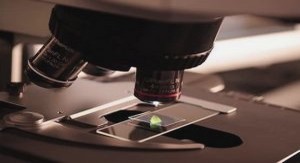Les effets des racines, des vers de terre et de la matière organique sur les propriétés physiques des Technosols construits
Shrinkage analysis
Technosol samples were collected from the surface of each microcosm at the end of experiment using a 5 cm high, 5 cm diameter cylinder and were placed on a wet porous plate for saturation with deionized water according to manufacturer instructions (Sandbox, Eijkelkamp, Netherlands) for seven days by applying a water potential of 0 kPa at the base of the sample. The shrinkage curve was continuously measured according to Braudeau et al. (1999) by using the retractometer© apparatus. Water-saturated Technosol samples were placed in an oven at a constant temperature (30°C) to provide continuous and rapid evaporation.
An electronic scale (0.01 g precision) ensured accurate measurement of water loss during drying. Each sample’s volume (diameter, height) was determined with laser beams and recorded along with its mass every 10 minutes. At the end of the measurement, samples were dried in an oven at 105°C for 48 h to measure dry mass and bulk density. These data were converted into soil specific volume (V, cm3 soil .g – 1 dry soil) and water content (W, g water.g-1 soil). We then determined the soil shrinkage curve (SSC) to describe hydro-structural properties, as proposed by Assi et al. (2014). The data obtained by shrinkage measures were fitted according to the pedostructure model (Braudeau et al. 2004). In this model, the SSC is subdivided into a maximum of four shrinkage phases (interpedal/saturated (ip), structural (st), basic (bs) and residual (re) shrinkage phases) that are due to four types of water (Wip,Wst, Wbs, Wre) (Fig. 1). The pedostructure is considered an assembly of primary peds (aggregates made of the clayey particles) that determines two nested levels of organization: the macropore level (containing Wma = Wip + Wst) and the micropore level (containing Wmi = Wre + Wbs). These levels do not refer to pore size by itself, but to water pore behavior during soil drying. Based on this distinction, the two pore systems were also called plasma (micropores) and structural properties (macropores) (Boivin et al., 2004; Schäffer et al., 2008)
Plant harvest and root size distribution
Plants were cut at the soil surface 21 weeks after sowing. Fresh leaves were weighed, dried in an oven at 50°C for two days and weighed again. Root mass was estimated from one quarter of the pot, since other quarters were used for physico-chemical and shrinkage analyses, which requires not disturbing soil physical characteristics (i.e. root or earthworm sampling). Dry root biomass distribution among diameter classes was determined according to the method of Blouin et al. (2007). It is based on the granulometry method used to assess soil texture: roots are dried, cut transversely with a mixer and placed on a column of sieves with decreasing mesh size. During the shaking of the sieve column, root fragments with a section diameter smaller than the mesh size pass through this mesh and stop on the first sieve with a mesh size below that of the root section diameter. Biomass distribution is assessed by weighing the biomass recovered in each sieve. Five diameter classes were chosen according to sieve mesh size: 0-100, 100-200, 200-400, 400-800 and >800 µm.
Data analysis
We calculated means and standard errors of hydro-structural parameters for all treatments by fitting the curves with the hydro-structural model (Table S2). The hydro-structural parameter representing the slope of the interpedal Kip phase, the kM parameter related to the shape of the soil shrinkage curves and Kre the slope of the residual phase were not included, since they 112 were constants for all mixtures (Kip = 1), (kM = -53) and (Kre = 0)Statistical analyses were performed with the R 3.0.3 software (R Core Team 2014). To assess the correlation of each factor’s influence on the variance of the eight hydro-structural parameters, redundancy analysis (RDA) was performed with the Vegan package (Jari Oksanen, F et al. 2013).
Then partial RDA was performed to decompose the variation of hydro-structural metrics according to the combination of GWC, organisms and their interaction. Differences between treatments were tested with Tukey’s honest significance test. To identify which hydro-structural variables separated the treatments, the MASS and ade4 packages were used for principal component analysis (PCA) (Venables and Ripley, 2002) and for linear discriminant analysis (LDA) (Dray and Dufour, 2007). Treatment separation based on hydro-structural variables was tested with Wilks and Pillai tests. The influences of the presence/absence of earthworms and the percentage of GWC were assessed with two-way or three-way ANOVA with GWC, earthworms and plants taken separately. Independent variables were considered to have an influence on dependent variables when the probability value was < 0.05.



